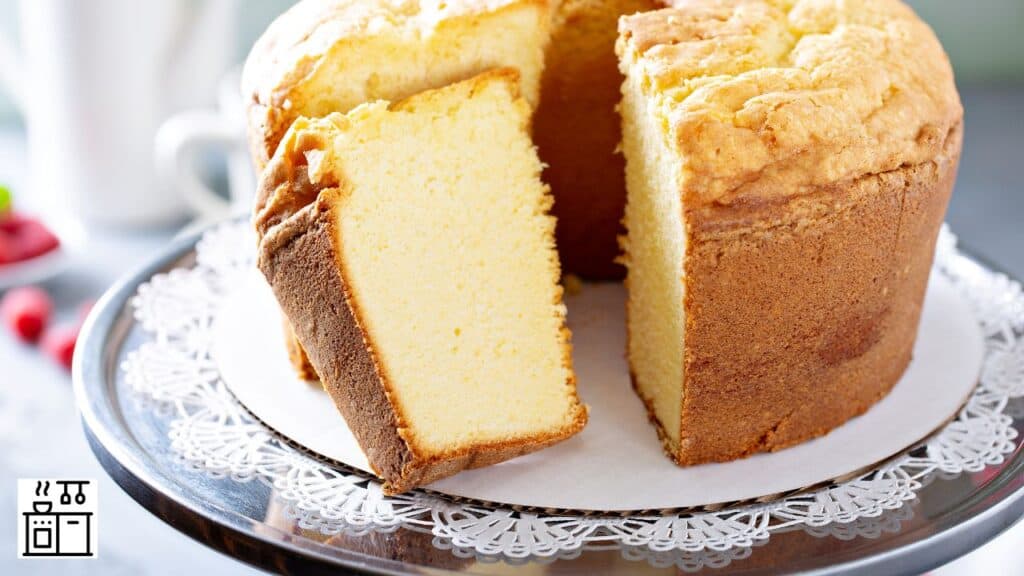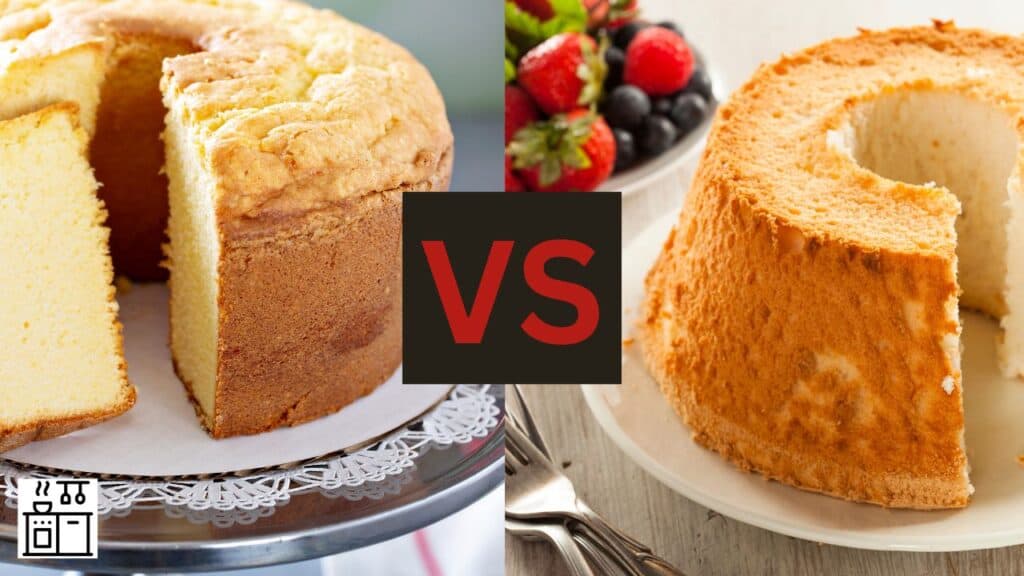Pound cake is a popular dessert known for its dense and moist texture. Its rich, buttery flavor comes from the use of butter, milk, and cream in its preparation. On the other hand, angel food cake is light and airy. It’s primarily made from whipped egg whites and contains no fat.
These differences in ingredients not only give each cake its unique flavor and texture but also make them suitable for different occasions and personal preferences.
You’ll often find pound cake served with a dollop of whipped cream or a drizzle of icing, while angel food cake is usually paired with fruits or whipped cream for an added touch of sweetness.
Let’s now take a deeper look into the history and distinct features of these two popular desserts.
Origin and History of Pound Cake and Angel Food Cake
Pound Cake and Angel Food Cake are both time-honored favorites, but they have distinct histories that might surprise you.
Origin and History of Pound Cake
Believe it or not, pound cake has been around since the 1700s. It’s thought to come from Northern Europe.
The name? It tells a story all on its own.
Back in the day, one pound each of flour, sugar, butter, and eggs was all it took to make this hearty cake – hence the name “pound” cake.
While literacy wasn’t widespread then, remembering four ingredients in equal parts? Piece of cake!
The earliest written proof we have for pound cake is found in Hannah Glasse’s book ‘The Art of Cookery’, published way back in 1747.
And if you think pound cake is just a European thing – think again! The first U.S. cookbook, American Cookery (1796), showcases the pound cake recipe too.
Origin and History of Angel Food Cake
Angel food cake flew onto the scene later than pound cake – somewhere during the 1800s in America.
The angel food cake got its first detailed recipe print debut in none other than the Boston Cooking School Cook Book back in 1884.
There are competing theories about who should get credit for this cake’s creation though.
Some historians believe African-American slaves birthed angel food cakes because hard labor was involved in whipping up the egg whites to fluffy perfection.
Others point out southeastern Pennsylvania as a possible birthplace because it was swarming with cake mold producers during the early 1800s when angel food cakes made their appearance.
Regardless of who deserves credit for creating angel food cake, there’s no denying its appeal soared throughout the early 1900s as folks craved lighter desserts that wouldn’t bust their waistline like traditional cakes might’ve done.
How Do the Textures of Pound Cake and Angel Food Cake Differ?
Let’s now take a look at the differences in textures between pound cake and angel food cake.
Pound Cake Texture
A pound cake is dense and moist. The close-textured crumb is what makes the pound cake stand out from the crowd.
The pound cake recipe contains a significant amount of butter, resulting in a rich, indulgent flavor that melts in your mouth.
Despite its density, it should not feel gummy or heavy.
Angel Food Cake Texture
If pound cake is dense and rich, then angel food cake is its polar opposite: light, airy, and fluffy.
Angel food cake has a soft, crumbly texture that melts in your mouth.
This texture is achieved by whipping egg whites until they’re fluffy and then incorporating them into the batter.
Unlike pound cake, angel food cake contains no fat. It’s also characterized by its crust, which typically has a light golden color that contrasts beautifully with the pale inside of the cake.
How Do the Key Ingredients Differ in Pound Cake and Angel Food Cake Recipes?

When you’re baking, knowing the key ingredients for your chosen recipe is crucial. So let’s check out the key ingredients that make a pound cake and an angel food cake unique.
Common Ingredients Used in Pound Cake Recipes
A pound cake has these main ingredients:
- Butter: Usually unsalted, it gives that rich, buttery flavor.
- Sugar: Granulated sugar adds just the right amount of sweetness.
- Eggs: Large ones at room temperature provide richness, moistness, and stability.
- Flour: All-purpose flour forms the backbone of the cake structure.
- Vanilla extract: This little addition brings out a delightful flavor.
- Baking powder (optional): Some bakers use it as a leavening agent, but traditional recipes don’t include this ingredient.
- A pinch of salt enhances all other flavors.
- Lastly, some recipes might call for milk to create a more tender and moist texture.
You can play around with these base ingredients by adding lemon zest or spices like nutmeg for new twists on this classic cake.
Common Ingredients Used in Angel Food Cake Recipes
On the other hand, angel food cake contains the following ingredients:
- At the top of the list are large egg whites at room temperature. They’re responsible for creating that light-as-air texture.
- Again, granulated sugar sweetens things up nicely without overpowering other flavors.
- We then have low protein content cake flour, which helps create a tender crumb structure.
- With cream of tartar at hand, you can stabilize those egg whites and maintain their structure during baking.
- A touch of vanilla extract adds depth to the overall taste profile.
- A dash of salt brings forth all those heavenly flavors.
- Some recipes suggest incorporating water or extracts which help moisten the angel food cake while also enhancing its taste.
Tips for Making Perfect Pound Cake vs. Angel Food Cake
Here are some tips that’ll help you ace the art of making a perfect pound cake and an angel food cake.
Tips for Making Perfect Pound Cake
Baking a pound cake might seem simple, but the below tricks can ensure that you get it right every time:
- Always opt for high-quality ingredients. They really do make a difference.
- Ensure that your butter, eggs, and other dairy items are at room temperature before mixing them up.
- It’s crucial to cream butter and sugar together till it’s light and fluffy. This way, you’re incorporating air into the batter, which further helps in rising during baking.
- Overbeating eggs is a big no! Add one egg at a time and beat until the yolk disappears.
- Precise measurements can’t be skipped while baking. They maintain the balance of flavors and textures in your cake.
- Be gentle with your batter; avoid overmixing as this may result in activating excess gluten resulting in dense cakes.
- Grease up that baking pan properly. And don’t forget to sprinkle some flour too.
- An oven thermometer can be your best friend when aiming for even baking temperatures.
Don’t peek constantly into the oven while your cake bakes; opening the oven door often may cause uneven baking or even make it fall.
After taking the cake out of the oven, let it cool off sufficiently before slicing it.
Related Reading: Sponge Cake vs. Angel Food Cake
Tips for Making Perfect Angel Food Cake
Here are some tips to make lighter-than-air angel food cake:
- Room-temperature egg whites whip better, so always keep them ready beforehand.
- Be very careful while separating yolks from whites; even traces of yolk can prevent proper whipping of egg whites.
- Use Cake flour since it has low protein content, which ensures fluffiness in angel food cakes.
- Whip those egg whites until they form soft peaks rather than going all stiff peaks on them.
- Cream of tartar stabilizes egg whites giving them structure during baking.
- Dry ingredients should be gently folded into whipped egg whites slowly so as not to deflate them.
- In contrast to other cakes where it’s recommended to grease the pans, for angel food cake recipe, it’s not suggested. This is because the batter requires a surface it can adhere to.
- Bake at higher temperatures since it ensures quick rise rendering light and airy texture.
- Invert the cake right after you remove it from the oven. Place it on a cooling rack or a bottle-neck while it’s still in its pan. This step prevents the cake from collapsing as it cools down.
- Always use a serrated knife to cut the cake. This ensures each piece remains whole and intact every time.
With these tips handy, you can make perfect pound cakes or angel food cakes every time. So go ahead and put on that baker’s hat and start whisking away.

